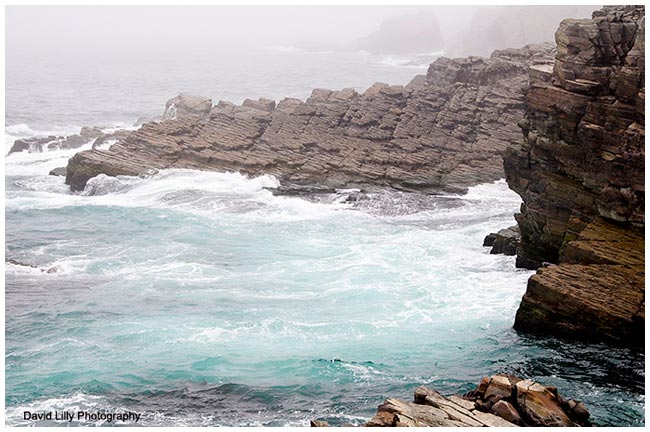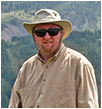
Newfoundland an Undiscovered Jewelby David Lilly
In our travels we concentrated mostly on the Avalon Peninsula on the east part of the island. This part of Newfoundland is very accessible by road and has some of the most stunning landscapes to be found anywhere on the island. The Avalon Peninsula protrudes out in a southerly direction with unobstructed views to the west and east over the Atlantic Ocean. The sunsets are awe inspiring –when it is not foggy. Our first stop was at Placentia after we left the Trans Canada Highway. We were lucky and got a good sunset on Long Beach in Placentia. We were luckier the next day as we traveled to one of the biggest Northern Gannet colonies on the east coast of North America at Cape St. Mary’s. It was very foggy, but as we approached the cliffs to photograph the Gannets the fog started to life and we got some excellent photographs. Just a note if you visit this area, the cliffs around the gannets have a 400 ft drop straight to the sea below. We got some excellent photographs of the Gannets and great photographs showing the ruggedness of the Newfoundland landscape. I would say these photographs are typical of the landscape found along the south coast. The next day we visited the museum at Cape Race a little farther east hoping to get a nice landscape with the lighthouse, but were fogged in again. A woman who works at the museum said it is foggy for 250 days a year on the average at Cape Race. From Cape Race we stopped at a location where there are fossils more then 500 million years old. It was there that I got If you plan a trip to Newfoundland give yourself plenty of time (2-3 weeks minimum). If you can, fly into St. John’s and rent a car I recommend dropping it off in Stephenville or Deer Lake on the west coast. This way you won’t have to back track. For day trips from St. John’s I recommend driving the Irish Loop which includes the popular Cape Spear, the most easterly point in North America. If you have more time (weeks) head west on the Trans Canada Highway and look for highway signs that mark the scenic smaller highways around the bays this is where you will get a true feeling of Newfoundland and get to photograph excellent landscapes.
If you go to Newfoundland remember to bring rain gear. For camera equipment you will need to a long lens and a wide angle lens. A tripod is a must because light is low on foggy days. Don’t forget a plastic cover for your camera. A lens cloth will come in handy as the fog seems to stick to everything. Take notes as to where you photographed as some of the place names are not on any maps. Motel, hotels and Bed and Breakfasts are few in some areas, so I again recommend booking these facilities in advance. Cell phone coverage is limited in many costal areas. The best months to visit weather wise are June, July and August, but there are no guarantees. A final word for visiting Newfoundland for landscape photography bring lots of digital storage space as there will be landscape photographic opportunities around every bend. Watch out for moose, keep an eye on the ocean for whales and get yourself a Newfoundland dictionary for translation. Remember, Cod Tongues are special treat in Newfoundland.
|

 This past summer 2008 me and my wife went and visited my home town Gaultois and the Avalon Peninsula on the South West Coast of Newfoundland. We flew into St. John’s rented a car and drove the boring seven hours to my home town. We spent a few days with my family members before heading out to take pictures. My photographic objective was to try to capture the Newfoundland landscape I loved when growing up there more then thirty years ago. I tried to capture the landscape’s ruggedness, the cliffs protruding out into the fog, the sea bashing against the rocks, the loneliness and the isolation of being on an island in the middle of the North Atlantic. It also became obvious as we drove from small town to small town that many houses were abandoned by Newfoundlanders that packed up and left. To add to my theme of loneliness I photographed many of those houses. For me those old abandoned houses brought on a lot of sadness. They represented a time in Newfoundland’s history when there was much more life - a life based on the fish and the sea nearby.
This past summer 2008 me and my wife went and visited my home town Gaultois and the Avalon Peninsula on the South West Coast of Newfoundland. We flew into St. John’s rented a car and drove the boring seven hours to my home town. We spent a few days with my family members before heading out to take pictures. My photographic objective was to try to capture the Newfoundland landscape I loved when growing up there more then thirty years ago. I tried to capture the landscape’s ruggedness, the cliffs protruding out into the fog, the sea bashing against the rocks, the loneliness and the isolation of being on an island in the middle of the North Atlantic. It also became obvious as we drove from small town to small town that many houses were abandoned by Newfoundlanders that packed up and left. To add to my theme of loneliness I photographed many of those houses. For me those old abandoned houses brought on a lot of sadness. They represented a time in Newfoundland’s history when there was much more life - a life based on the fish and the sea nearby.  more excellent landscapes. We drove up to the Irish Loop and followed it to Fairyland. In Fairyland there is a beautiful lighthouse set on a point of land that can only be described as a classic Newfoundland landscape. One of our day trips was to the Bay Bulls for the classic Puffin and whale watching trip. The Puffins Colonies are on an Island and unless you have a 600mm lens or longer forget about great photographs. The whales are nice to watch in the distance as they exhaust there giant sprays of water.
more excellent landscapes. We drove up to the Irish Loop and followed it to Fairyland. In Fairyland there is a beautiful lighthouse set on a point of land that can only be described as a classic Newfoundland landscape. One of our day trips was to the Bay Bulls for the classic Puffin and whale watching trip. The Puffins Colonies are on an Island and unless you have a 600mm lens or longer forget about great photographs. The whales are nice to watch in the distance as they exhaust there giant sprays of water. 
